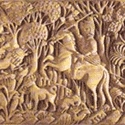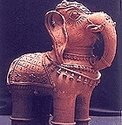The Bhutanese produce a variety of highly prized utilitarian turned wooden bowls, cups, plates, dishes and containers, all of which they use in their daily life. These bowls and containers come in different shapes, sizes, and colours, which distinguish the different uses that each is put to – a monk’s bowl, a serving bowl, a rice bowl, or a soup bowl being common examples. Made from wood with the help of slow-revolving, pedal-operated lathes, these bowls remain unaffected by heat or liquid and are lacquered with indigenous materials. Often, the smaller tea or soup bowls may be inlaid with silver, which makes them even more attractive and also enhances their lasting ability.
RAW MATERIALS
The lush forests of Bhutan have provided craftsmen through the centuries with a rich source of hard, semi-hard, and soft wood required to prepare functional and decorative products. The woods used include the chellum, etometo or rhododendron, maple, and kushing.
Lac, extracted from the Rhus succedanea tree is used for finishing the turned wood articles.
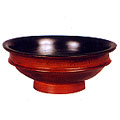
PRACTITIONERS & LOCATIONS
These articles are mainly produced in the Tashi Yangtse region of eastern Bhutan.
PROCESS & TECHNIQUE
Wooden bowls and receptacles are turned on foot-powered treadle lathes. The lathe is operated manually with the feet. Two people work simultaneously – one to shape and the other to operate the lathe.
Some bowls and all receptacles are lacquered black or red with a substance extracted from the Rhus succedanea. This is the same substance that the Japanese use for lacquer, but in Bhutan the finishes are less sophisticated. Bhutanese lacquering is applied manually with the thumb. To obtain a high-quality finish, the process is repeated six to seven times; four or five applications are used to impart a medium-quality finish and two or three applications are done for functional articles of that are not particularly good in quality.
Bowls lined with silver are used only for butter-tea or alcohol. Wooden receptacles are used as serving dishes for food and also as plates by the heads of the household.
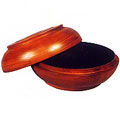
PRODUCT RANGE
- Thokey: Fruit BowlA traditional article, that is used during religious ceremonies and on special occasions.
- Tsamdeg: Serving Bowl with LidThe Tsamdeg was originally used for tsampa (barley or wheat flour)The product originated in the north and extreme east of Bhutan where roasted wheat and barley flour comprised the staple diet.
- Baw Dapa: Rice Plate with Lid
The Baw dapa with a lid is traditionally used to serve rice in. The dapa is 10 inches in diameter and has a lid. It is used especially by lamas, monks, and dignitaries. - Dumchem Dapa: Rice Plate with LidThis wooden round container with a lid is traditionally used to serve rice in.
- Gophor: Cup with Lid
The gophor is traditionally used for drinking liquids like tea and soup. - Laphor: Bowl with Lid
The laphor is traditionally used by the monastic community, for tea and soup. - Boephor: Cup
The beophor is traditionally used for drinking wine, curry, or tea. People carry it on their persons, saving their host from having to provide cups when serving liquid refreshment. Men carried two cups wrapped in cloth plus a knife at the waist, while women carry one cup. It is wiped or washed with warm water. - Za Phob: Burl Cup
It is the Bhutanese ceremonial cup of wooden burl with natural lacquer used to drink tea and wine in. - Samden:
This is 1″ height and 1″foot broad and is used for serving snacks in.
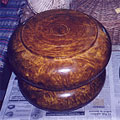
The prices of the products depend on the quality of wood used, the quality of the lacquer finish, and the presence or absence of silver mounting.
CONTEMPORARY TRENDS
Of late, under royal patronage, bowls are being made of ivory inlaid with silver. The availability of wooden bowls is rather limited, since production skills have traditionally been confined to a few centres in the country. The government has initiated steps for large-scale production of wooden bowls by training more people in the craft at the Uchu village in Paro, one of the traditional centres. Because of their attractive shapes and colours they are a favourite with tourists and have immense potential for export.

